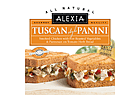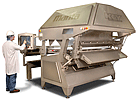Actually, this new product from Alexia Foods, Long Island City, N.Y., has nothing to do with fast food. But, Alexia is known for its upscale frozen Oven Fries, Julienne Fries, Waffle Fries and Mashed Potatoes.
Now the premium brand is attracting attention for another reason: Alexia Tuscan Style Panini.

Product Spotlight
Alexia Tuscan Style PaniniWant fries with that?
Actually, this new product from Alexia Foods, Long Island City, N.Y., has nothing to do with fast food. But, Alexia is known for its upscale frozen Oven Fries, Julienne Fries, Waffle Fries and Mashed Potatoes.
Now the premium brand is attracting attention for another reason: Alexia Tuscan Style Panini. These all-natural frozen panini sandwiches hit retail freezercases nationwide this summer and represent the business’ first foray into the frozen sandwich category.
“Inspired by Alexia founder Alex Dzieduszycki’s European travels, the four chef-inspired varieties feature specialty cheese, premium vegetables, Italian herbs and extra virgin olive oil on Alexia’s signature artisan bread,” says company spokesperson Annie Haas. “The [Panini] deliver a truly gourmet experience in the frozen sandwich category.”
Varieties include Smoked Chicken with Fire Roasted Vegetables & Parmesan on Tomato Herb Bread, Grilled Steak with Mushrooms & Onions on Italian Herb Bread, Grilled Chicken Pesto with Mozzarella on Italian Herb Bread and Four Cheese with Roasted Tomatoes & Basil on Tomato Herb Bread.
The trans fat-free panini are intended for consumers “who crave a more delicious and all-natural lunch or light meal alternative,” Haas says.
“The Alexia Tuscan Style Panini also offers the time-saving convenience of the patented, microwave grilling technology,” she adds.
The Panini come in ready-to-microwave packaging that features a “special grilling plate.” They cook in the microwave in approximately three minutes.
The Panini come individually packaged in a colorful paper-based box and are distributed nationally at both natural and mainstream food stores.

Supplier Spotlight
Key Technology’s Manta SorterYou’ve heard that bigger is better.
Key Technology Inc., Walla Walla, Wash., believes that its latest offering, the Manta Sorter, is bigger and better in terms of both volume and sorting accuracy.
Officials say the Manta has a two-meter wide scan area that dramatically increases throughput within a space-saving footprint. Meanwhile, it handles up to 27 metric tons (60,000 pounds) of processed vegetables or fruit per hour, detecting and removing the smallest defects and foreign materials.
“Bonduelle, one of the largest vegetable processors in Europe, recently installed a Manta, configured to handle a range of vegetables - including peas, multiple varieties of beans, multiple forms of carrots and other vegetables,” says Bret Larreau, Processed Vegetable and Fruit Industry marketing manager. “Every customer that has seen Manta in operation at our test facility has been impressed with its performance, simplicity and ease of use.
We are excited that in addition to Bonduelle, we have multiple Manta sorters being installed in various plants around the world for the upcoming 2008 processing season.”
Key says the Manta has the highest number of sensors and image processing modules of any sort on the market, and it maintains the highest resolution of the finest narrow-belt sorters - all on its wider, higher capacity frame. And, with flexibility in mind, Key says it can configure Manta with up to eight top-mounted color or Vis/IR (visible infrared) cameras and up to two top-mounted FluoRaptor fluorescence-sensing lasers.
To Larreau’s point about simplicity, Key designed Manta to be self contained and complete. Unlike other sorters that may require separate cooling systems, water filters and air dryers, Manta incorporates all the necessary components into one system. Users simply can connect air, water and power and start sorting. Officials add that the machine has fewer horizontal surfaces, stainless steel construction, water-tight double gaskets on doors, a sealed control panel and easy access to cleaning areas.
Key plans to debut the Manta at this fall’s Process Expo / Pack Expo 2008 in Chicago.
Flack: New products key to Schwan future
Despite its tremendous size and diversity, frozen food giant Schwan Food Co. still has room to grow in natural and organic products, reported TheMarshall (Minn.) Independentnewspaper. Greg Flack, the company’s newly appointed chief executive officer, president and chief operating officer, said that …… Schwan is still “young” in areas involving natural ingredients and organic products;
… Schwan will apply innovative techniques from its frozen dessert and frozen pizza lines to other core product areas;
… Schwan needs to “focus on” its core businesses within the consumer brands, home service and foodservice markets;
… Schwan has room to grow in such limited assortment markets as dollar stores and drug stores.
New products drive Heinz growth
Pittsburgh’s H.J. Heinz Co. - parent to such frozen offerings as Smart Ones, Ore-Ida and Bagel Bites - expects new products to drive much of the company’s projected 6 percent organic sales growth during fiscal 2009. In its fiscal 2008 year-end release (issued May 29), Chairman, President and Chief Executive William Johnson said Heinz expects to launch more than 400 new products during the next 12 months, to be supported by an incremental marketing spend of $60 million to $100 million.Heinz said it is “expecting accelerated growth in health and wellness, which is growing two times faster than all packaged foods.” The company’s portfolio includes better-for-you tomato sauces, baked beans, soup, low-calorie meals and infant nutrition.
Looking back on fiscal 2008, Heinz identified several new frozen products as growth contributors. These included Smart Ones Anytime Selections (hand-held entrees), Smart One Fruit Inspirations (entrees featuring added fruit portions) and several new Boston Market products.
Private label products take new direction
As reported byRefrigerated & Frozen Foods Retailer (RFFR), Safeway Stores, Pleasanton, Calif., designed two of its lines - O Organics and Eating Right - to more closely resemble mainstream brands, rather than private label offerings. O Organics now spans about 350 offerings ranging from milk to frozen edamame. Safeway positions the Eating Right line - with 250 offerings, including frozen dinners - as a balance of taste and nutrition. Interestingly, Safeway is laying the groundwork to distribute both lines in places other than its own stores - including school cafeterias, foreign markets and, ultimately, other U.S. grocers.RFFRsays Safeway’s experiment is “breaking the mold on what we all thought we knew about private label.”Formulating for kids? Do your (insights) homework
Think you know what kids’ tastes are? Think moms are in tune? Think again.A new survey about kids’ fruit and vegetable trends suggests that - although kids voted broccoli among their top three favorite vegetables - moms didn’t rank it in their top five most purchased.
Produce for Kids, an educational group in Orlando, Fla., says it surveyed nearly 1,500 moms and kids about their fruit and vegetable consumption habits and preferences. Kids said their top five favorites are carrots, broccoli, corn, green beans and peas. Based on their top-purchased items per week, moms said kids like potatoes, baby carrots, tomatoes, lettuce/salads and corn.
Pollsters said fruit preference responses showed more consistency. Moms and kids alike ranked bananas, apples, grapes, strawberries and easy-to-peel citrus fruits (such as oranges and Clementine tangerines) at the top of both lists.
Interestingly, the survey showed that dips are hip. Seventy percent of kids like salad dressings as dips for fruits and vegetables.
Just the facts
“Mom, where do my peas come from?” According to a recent study, a larger number of consumers want to know not only about their food’s country of origin(73 percent)- but also the “healthiness” of the ingredients (61 percent), possible use of detrimental chemicals (49 percent) and safety of its ingredients (49 percent).Source: Deloitte
Foods that make you healthy - and beautiful too? It sounds too good to be true, but consumers all over the world are buying into foods that claim both health and beauty benefits. While just emerging in the U.S., this trend already has a secure hold in Asia and Europe. In the U.S., the functional food market was a$97 billionbusiness last year, with the average American spending $90 on functional products.
Source: Packaged Facts
According to at least one study, there are vast differences in the nutritional needs of men and women. Australian scientists at the University of Sydney and Massey studying male and female Australian black field crickets, found that male crickets live longest and have the greatest reproductive success with a diet that has a carbohydrate toprotein ratio of eight-to-one,whereas females have greatest success when the ratio is one-to-one. The scientists believe the findings could apply to human males and females as well.
Source: Medical News Today